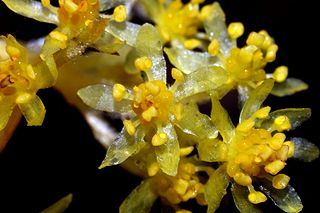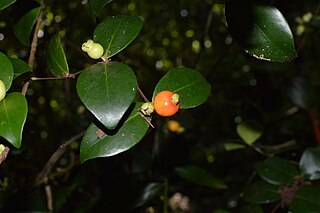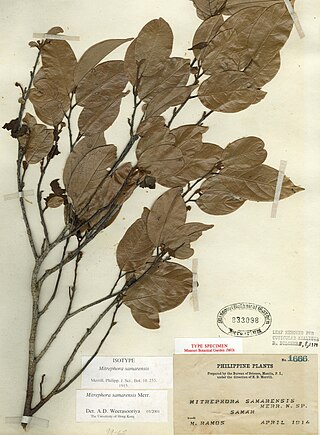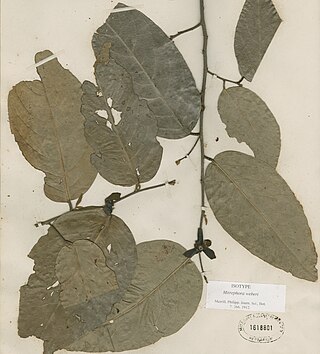
The superb fruit dove, also known as the purple-crowned fruit dove, is a medium-sized, colourful fruit-dove in the family Columbidae.

Cryptocarya is a genus of evergreen trees belonging to the laurel family, Lauraceae. The genus includes more than 350 species, distributed through the Neotropical, Afrotropical, Indomalayan, and Australasian realms.

Neolitsea dealbata, also known as white bolly gum, hairy-leaved bolly gum, or simply bolly gum, is a shrub or small tree in the laurel family Lauraceae which is native to New South Wales and Queensland in Australia.

Adonidia merrillii, the Manila palm, is a palm tree species native to the Philippines. This palm was cultivated for centuries in East Asia before becoming a staple in the West. It is reportedly naturalized in the West Indies and Florida. It is commonly known as the "Christmas palm" because its fruits become bright scarlet and tend to be that color in winter. This palm is typically fairly small and slender, normally attaining 25 feet or 8 meters in height but has attained over 40 feet in some instances. Most plants maintain 5-7 fronds when young, gradually building up the crown as the palm ages, and sometimes reaches 10-12 fronds when mature.

Aglaia argentea is a species of plant in the family Meliaceae. It is a tree found in Australia, Brunei, India, Indonesia, Malaysia, Myanmar, Papua New Guinea, the Philippines, the Solomon Islands, and Thailand.
Mitrephora fragrans is a species of plant in the family Annonaceae. It is native to Borneo and The Philippines. Elmer Drew Merrill, the American botanist who first formally described the species, named it after its large, fragrant flowers.

Sassafras randaiense is a species of deciduous tree in the family Lauraceae belonging to the genus Sassafras. It is a relict species endemic to Taiwan. It is threatened by habitat loss.

Cryptocarya laevigata, known as the glossy laurel or red-fruited laurel, is a rainforest plant, which ranges from Malesia and New Guinea to eastern Australia. In Australia it grows in the rainforest understorey on fertile soils, from the Richmond River, New South Wales to Cairns in tropical Queensland, where it is often seen in association with the White Booyong.

Camphora glandulifera, common name false camphor tree or Nepal camphor tree, is a tree in the genus Cinnamomum of the family Lauraceae.

Cinnamomum mercadoi (kalingag) is a small tree, about 6 to 10 metres high, with a thick, aromatic bark. The plant part of the family Lauraceae, which contains about 45 genera and 2000-2500 species, and is related to the culinary cinnamon, sassafras, and bay tree. The plant is indigenous to the Philippines, where it grows best in forests at low and medium altitudes that sometimes ascend to 2,000 metres (6,600 ft). C. mercadoi is unusual in the cinnamon family in that its essential oil consists large amounts of safrol, whereas other oils of cinnamon contain cinnamaldehyde. It is currently listed in the International Union for Conservation of Nature (IUCN) Red List as "vulnerable" due to the overharvesting and the continuous loss of the Philippine forests.

Toona sureni is a species of tree in the mahogany family. It is native to South Asia, Indochina, Malesia, China, and Papua New Guinea. It is commonly known as the suren toon, surian, limpaga, iron redwood or the red cedar. It is also known as the Indonesian mahogany or the Vietnamese mahogany. The species is a valuable timber tree.
Cryptocarya ferrarsi is a species of small forest tree in the family Lauraceae. It is endemic to the Middle Andaman Island of India.

Eugenia palumbis is a shrub with edible fruits in the family Myrtaceae. It is endemic to the Mariana Islands, including Guam and the Commonwealth of the Northern Mariana Islands.
Saurauia klemmei is a species of plant in the family Actinidiaceae. It is native to the Philippines. Elmer Drew Merrill, the American botanist who first formally described the species, named it after Wilhelm Klemme, a German forest officer, who collected the specimen Merrill examined from Luzon island in the Philippines.

Saurauia papillulosa is a species of flowering plant in the family Actinidiaceae. It is endemic to the Philippines where it is known as papayang. Elmer Drew Merrill, the American botanist who first formally described the species, named it after the distinctive abundant small bumps, or papillae, on the underside of its leaves.
Huberantha flava is a species of plant in the family Annonaceae. It is native to The Philippines. Elmer Drew Merrill the American botanist who first formally described the species, using the basionym Polyalthia flava, named it after its brilliant yellow flowers.

Mitrephora samarensis is a species of plant in the family Annonaceae. It is native to the Philippines. Elmer Drew Merrill, the American botanist who first formally described the species, named it after Samar, the third largest island in the Philippines, where the sample he examined was collected.

Mitrephora weberi is a species of plant in the family Annonaceae. It is native to The Philippines. Elmer Drew Merrill, an American botanist, first formally described the species and named it after Charles Martin Weber who collected the specimen that Merrill examined.

Cryptocarya anamalayana is a rare rainforest tree endemic to the southern Western Ghats, India. The specific epithet of the name refers to the Anamalai Hills, a major area of its distribution. The species considered endangered under the IUCN Red List of Threatened Species.

Cinnamomum philippinense is a species of flowering plant in the family Lauraceae, native to Taiwan and the Philippines. It was first described by Elmer Drew Merrill in 1906 as Machilus philippinensis.

















